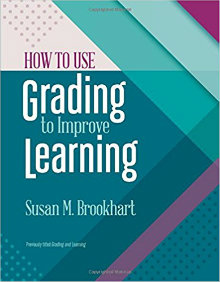How to Use Grading to Improve Learning
How to Use Grading to Improve Learning
By Susan M. Brookhart
(ASCD, 2017 – Learn more)
 Reviewed by Emily Prissel
Reviewed by Emily Prissel
No matter where you are in your journey to understand grading, this book can help. Thinking about grades, assessment, and learning is enough to make anyone’s head spin. Susan Brookhart does a nice job of presenting important ideas succinctly and clearly, while giving practical advice and ready-to-use strategies and resources.
Personally, I am using a standards-based grading system in a district and building that is not. While Brookhart doesn’t necessarily recommend going standards-based, the movement for standards-based comes from much of the same reasoning she discusses.
Grades communicate learning
 The first few chapters (Part I) of this book helped to solidify and confirm many of the beliefs I already hold. The big takeaway of these first few chapters is that grades are a way to communicate learning not behavior – not effort, not likeability, but learning.
The first few chapters (Part I) of this book helped to solidify and confirm many of the beliefs I already hold. The big takeaway of these first few chapters is that grades are a way to communicate learning not behavior – not effort, not likeability, but learning.
Part II delves into strategies that you can begin using in your classroom right away. I really enjoy that the author sets things up for people at any point in this grading process. Whether you’ve never even thought about how you grade or you have a system that you’ve worked on and perfected over many years, there are tips and strategies for you to use. There are even sample rubrics to modify! There are also some great checklists for you to use in creating your assessments and setting up gradebooks.
Ready for a major shift?
Part III is perhaps the most helpful section if you’re ready to make a major shift. In fact, I wish I had had this book before I started my new grading system this year! In this section, Brookhart gives specific tips for beginning a learning-focused (note: not standards-based!) grading system. She even covers how to communicate the ideas with students and parents, as well as assessing if you and your building or district are ready to make the shift.
This book is geared more toward middle and high school teachers, but anyone who gives grades could benefit from the ideas. I would even recommend it to administrators who do not personally grade, but want to support teachers ready to make a shift. While many of the examples are for “core” teachers (ELA, Social Studies, Math, etc), the ideas could be used by any teacher who gives grades.
Overall, this is a practical and helpful guide for evaluating and improving your grading practices. I enjoyed that there are many researched-based elements to her ideas and recommendations. It has often been a struggle for me to find specific research to support elements of grading practices.
I don’t know that I’ll ever feel that my practices are perfect, but this book has definitely helped me think through and improve many elements in my own methods. I would definitely recommend this book to anyone that is willing and ready to dive into why they grade the way they do, how this practice impacts student learning, and what they may do to improve.
Be prepared for some difficult questions about what you do, but also lots of help and support along your journey.
Emily Prissel is a 7th grade English teacher in Wisconsin. She has been teaching for 6 years in middle school, with 2 years in high school English and history before. Currently, she is serving on both school-wide and district-wide committees focused on grading and assessment at the secondary level.


































